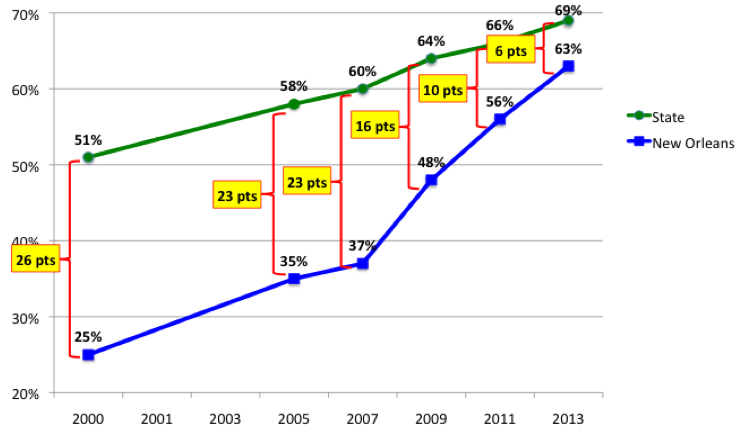Earlier this week my friend Checker Finn wrote a short, barbed blog saying in effect that charter folks shouldn’t brag too hard about outperforming dismal neighborhood schools when so many of our students remain far below acceptable levels of proficiency.
Good point, well aligned with our One Million Lives campaign, and a useful tonic for “irrational exuberance.” In 2005, when NAPCS published the report of our Task Force on Quality and Accountability (which included NACSA CEO Greg Richmond), one of our key principles was this: “Charter schools must achieve at high levels—not just offering something marginally better than failing neighboring schools, but providing the kind of education that equips graduates for success in postsecondary education, fulfilling work in the 21st century economy, and responsible citizenship.”
So, no question about it, we should be cracking down on any school that boasts about moving students from the first to the second percentile and calling it a “100% gain.”
But Dr. Finn makes the mistake of including this analogy in his brief treatise: “Would you be satisfied with your golf score if it were a few points lower than someone who shoots 100?” Well……personally, I’d be THRILLED, having spent ten years flogging away and never doing better than 108 for 18 holes. I’m starting from such a pathetically lousy base that shooting a 98 would demand long, loud celebration.
So, back to the topic. Today comes news from New Orleans that the charter-dominant Recovery School District ranked 57th out of Louisiana’s 70 public school districts on this spring’s tests. Which would be pretty awful had the RSD not inherited the lowest-performing schools in a system that was dead last 8 years ago, and had the overall proficiency rate in their schools not jumped from 28% in 2008 to 57% this year. Combined with more modest gains by the generally selective (and historically higher-performing) Orleans Parish schools, that means New Orleans as a whole is within shooting distance of overtaking statewide performance, as shown in the chart below.

Source; Educate Now! 2000-2011 includes grades 3-11 LEAP, iLeap, and GEE. 2012-2013 includes only grades 3-8 LEAP and iLeap because the GEE has been phased out and replaced by End of Course Tests and the ACT.
Now in absolute terms, I’d have to concede that there’s a way to go. Louisiana is not in the top rank of achievement among states. But gains like these are the foundation for making its graduates truly competitive on the national and world stage. You don’t get there overnight.
That’s why we celebrate gains, as long as they’re real and on a high enough trajectory to take kids to parity and beyond in the desperately short time schools have them.


